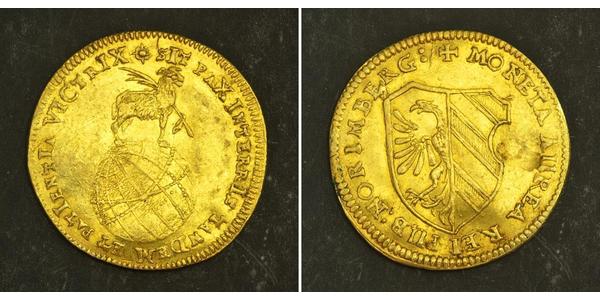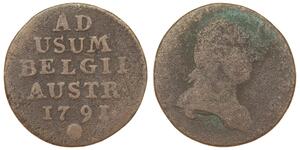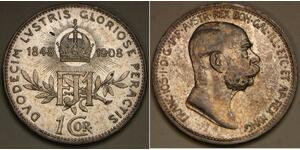(Vendida por $622.0)
1632, Nuremberg (Free City). Beautiful Gold "Lamb" Ducat Coin. Rare 1-Year Type!
Reference: Friedberg 1824, KM-123. R!
Mint Master: Hans Christoph Lauer (privy mark: star)
Denomination: Ducat - Civic coinage resumed (1-year type!)
Condition: Lightly deformed, minor scratches, otherwise XF!
Mint year: 1632 (date encoded as large letters in obverse legend)
Mint Place: Nuremberg (as free City within the Holy Roman Empire).
Material: Gold (.986)
Diameter: 22mm
Weight: 3.46gm
Obverse: Lamb of God (Agnus Dei), holding palm-spray and standing on earth as a planet.
Legend: * SIT PAX INTERRIS TANDEM ET PATIENTIA VICTRIX
Reverse: Halved shield with arms of the Empire (double-headed eagle) and Nuremberg.
Legend: + MONETA AUREA REIPUB : NORIMBERG :
For your consideration a rare gold lamb ducat, struck to commemorate the resumed civic coinage of the city. A very rare and handsome 1-year type and a great addition!
Nuremberg is a city situated on the Pegnitz river and the Rhine-Main-Danube Canal. It is located about 170 kilometres north of Munich. The cultural flowering of Nuremberg in the 15th and 16th centuries made it the center of the German Renaissance. In 1525, Nuremberg accepted the Protestant Reformation, and in 1532, the religious Peace of Nuremberg, by which the Lutherans gained important concessions, was signed there. In 1632 during the Thirty Years' War, the city, occupied by the forces of Gustavus Adolphus of Sweden, was besieged by the army of Imperial general Albrecht von Wallenstein.
Bid with Confidence!
Agnus Dei is a Latin term meaning Lamb of God, and was originally used to refer to Jesus Christ in his role of the perfect sacrificial offering that atones for the sins of humanity in Christian theology, harkening back to ancient Jewish Temple sacrifices.
Lamb of God (Latin: Agnus Dei) is one of the titles given to Jesus in the New Testament and consequently in the Christian tradition. It refers to Jesus' role as a sacrificial lamb atoning for the sins of man in Christian theology, harkening back to ancient Jewish Temple sacrifices in which a lamb was slain during the passover (the "Paschal Lamb", Hebrew: Korban Pesach), the blood was sprinkled on the altar, and the whole of the lamb was eaten. In the original Passover in Egypt, the blood was smeared on the door posts and lintel of each household
Only 1$ shipping for each additional coin purchased!
1 Liard Países Bajos Austríacos (1713-1795) Cobre
grupo tiene 7 monedas / 7 precios
⇑
1 Corona Imperio austrohúngaro (1867-1918) Plata Franz Josep ...
grupo tiene 25 monedas / 17 precios
⇑
















-300-150-NgSsHgTyCiIAAAGW1HxyjNgw.jpg)

-300-150-AeIKqUpY7NEAAAFhroEy54Nz.jpg)






